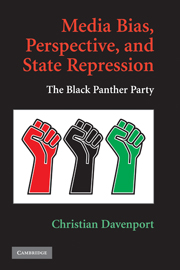'Scholars with an interest in social movements, repression, and/or the Black Panthers have been eagerly awaiting this book for the better part of a decade. It was worth the wait. The methodological implications of the work – as encoded in Davenport’s already well known Rashomon Effect – are reason enough to already regard the book as a classic. In addition, however, the work also represents a thoughtful, systematic study of the Black Panthers. Anyone who knows this troubled corner of the literature is sure to appreciate what a rare and welcome achievement this is.'
Doug McAdam - Stanford University
'This is an important book with an important argument. It shows that different news sources not only covered different events relevant to the Black Panther Party, but constructed different narratives about cause-effect relations between movement actions and state repression. The sequences of mainstream news stories showed state repression to be a response to a few high-profile Black Panther actions and showed state repression effectively crushing the Black Panther Party. The sequences of news stories in the movement news sources showed state repression to be a response to a much wider and more diffuse array Black Panther protest actions and showed Black Panther dissent continuing in the face of ongoing repression. Which theories of state repression got confirmed or rejected depended on which news sources you used. Christian Davenport provides the necessary context for this crucial analysis with informative and well-written summaries of research and theory on news coverage, state repression, and the history of the Black Panther Party and race relations in the Bay Area. The result is a book of crucial importance for scholars of social movements, state repression, mass media, and the history of the Black movement in the US.'
Pamela Oliver - University of Wisconsin
'This book explores the research implications of what Davenport terms ‘the rashomon effect'. Davenport’s careful analysis of multiple (and sometimes contradictory) newspaper accounts of contentious interactions between the Black Panther Party and authorities in California’s Bay Area yields a number of new and fascinating findings on the dynamics of protest, violence, and repression. In sum, this book makes a compelling argument for using varied sources of data on events as a method for understanding the process of collective action as experienced by different audiences.'
Susan Olzak - Stanford University
'This meticulously researched, well-written and broadly integrative book is simultaneously about a chief methodology used by scholars of contentious politics, and state repression of the Black Panther Party in the Bay Area during the late 1960’s. On the methodological level, the book illustrates the pitfalls of relying on single news source accounts of conflict and repression and it clearly delineates the sources of bias related to such news accounts. As such, the book stands out as a new and exciting addition to the growing literature on media bias and will become a classic text on this subject. On a substantive level, Davenport describes important events and details related to the state repression of a hitherto understudied social movement. Indeed, this work contributes to a much deeper and nuanced understanding of this movement during this period of time. Media Bias, Perspective and State Repression should be read and digested by political scientists, sociologists, historians, communications scholars and laypeople alike.'
Sarah Soule - Stanford University




